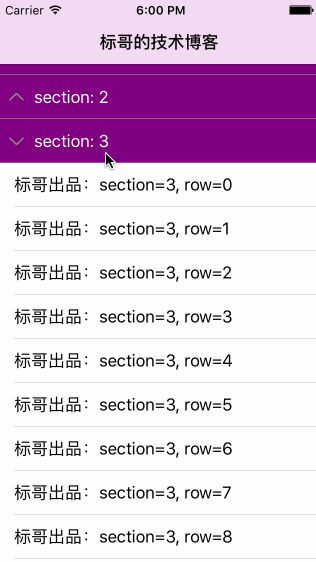UITableView分区展开与收起
概述
今天教大家利用UITableView的section实现像QQ那样的展开与收起的效果。其实实现起来是非常简单的,不过还是写一篇文章给大家讲讲思路并给新手参考的源代码。
简单,但是不同的人来实现也许会有不同的实现方式,简单程度也会不一样哦。其实与AppStore中的分类页面中的效果挺像的,不过人家那并不是这种动画效果,而是更美的动画!
文章内容
看完本篇文章,您将会学习到:
- 如何利用UITableView的section来实现展开与收起的效果
- 如何复用UITableView的header view
- 如何通过模型与UI结构一一对应,更好地解决cell复用问题
效果图
千言万语不如一张gif图来得实在,请看下面的效果:

设想
当看到这样的效果图时,您是怎么想的?如何实现呢?是否有现成的?动画是否满足需求?可扩展性够不够?
如果您对UITableView够熟悉,那么应该可以轻松想到UITableView的section,展开后就是UITableView的多个cell。
当然,如果不使用UITableView的section来实现,那么就需要自己解决复用的问题,反而麻烦化了。因此,本篇文章教大家如何利用UITableView来实现。
建立模型
UI的层级结构会与模型的结构一样,这样会最简化。首先,我们定义分区模型,每个分区模型代表一个区,区下面可以有很多个cell:
// 分区模型 @interfaceHYBSectionModel: NSObject @property (nonatomic, copy) NSString *sectionTitle; // 是否是展开的 @property (nonatomic, assign) BOOL isExpanded; // 分区下面可以有很多个cell对应的模型 @property (nonatomic, strong) NSMutableArray *cellModels; @end // 每个cell对应一个这样的model @interfaceHYBCellModel: NSObject @property (nonatomic, copy) NSString *title; @end
如此建立好模型与UI的层级关系后,使用起来是非常简单的。
自定义UITableViewHeaderFooterView
我们这里需要自定义UITableViewHeaderFooterView,因此需要子类化它。其实跟UITableViewCell的子类化是一样的,都有差不多的属性,使用起来也是一样一样的。
可能很多朋友没有见过有人使用这个东西。是的,在项目开发中,我也没有见过其他人使用它,全都是直接自定义一个UIView。这并不是不行,只是它不能与UITableView的复用联系起来。
我们自定义HYBHeaderView,那么注册复用headerFooterView就可以复用了:
[self.tableViewregisterClass:[HYBHeaderView class]forHeaderFooterViewReuseIdentifier:kHeaderIdentifier];
首先,我们先子类化UITableViewHeaderFooterView,我们需要传HYBSectionModel对象过来,代表一个分区头,通过model重写Setter方法,自动配置数据。因为展开与收起,我们添加了一个简单的动画,所以外部需要回调,我们给一个回调的闭包:
@class HYBSectionModel; typedef void(^HYBHeaderViewExpandCallback)(BOOL isExpanded); @interfaceHYBHeaderView: UITableViewHeaderFooterView @property (nonatomic, strong) HYBSectionModel *model; @property (nonatomic, copy) HYBHeaderViewExpandCallback expandCallback; @end
可能会有人问,[email protected]
,而不是直接引入头文件呢?其实,我在项目开发中, [email protected],而在实现文件中才真正地引入,这样可以避免循环包含而导致编译错误的问题。
我们的实现文件内容是比较少的,我们通过重写setModel方法来配置数据。我在项目开发中,几乎都是采用这种配置数据方式,除非一个cell会有多个地方共用。如果一个cell被多个地方共用,且model有的相同,有的不一样,这才需要特定写API来区分。我们是通过tranform来添加旋转动画的,实现起来非常简单:
#import "HYBHeaderView.h" #import "HYBSectionModel.h" @interface HYBHeaderView () @property (nonatomic, strong) UIImageView *arrowImageView; @property (nonatomic, strong) UILabel *titleLabel; @end @implementation HYBHeaderView - (instancetype)initWithReuseIdentifier:(NSString *)reuseIdentifier { if (self = [superinitWithReuseIdentifier:reuseIdentifier]) { CGFloat w = [UIScreen mainScreen].bounds.size.width; self.arrowImageView = [[UIImageView alloc]initWithImage:[UIImageimageNamed:@"expanded"]]; self.arrowImageView.frame = CGRectMake(10, (44 - 8) / 2, 15, 8); [self.contentViewaddSubview:self.arrowImageView]; UIButton *button = [UIButtonbuttonWithType:UIButtonTypeCustom]; [buttonaddTarget:selfaction:@selector(onExpand:)forControlEvents:UIControlEventTouchUpInside]; [self.contentViewaddSubview:button]; button.frame = CGRectMake(0, 0, w, 44); self.titleLabel = [[UILabel alloc]initWithFrame:CGRectMake(35, 0, 200, 44)]; self.titleLabel.textColor = [UIColor whiteColor]; self.titleLabel.backgroundColor = [UIColor clearColor]; [self.contentViewaddSubview:self.titleLabel]; self.contentView.backgroundColor = [UIColor purpleColor]; UIView *line = [[UIView alloc]initWithFrame:CGRectMake(0, 44 - 0.5, w, 0.5)]; line.backgroundColor = [UIColor lightGrayColor]; [self.contentViewaddSubview:line]; } return self; } - (void)setModel:(HYBSectionModel *)model { if (_model != model) { _model = model; } if (model.isExpanded) { self.arrowImageView.transform = CGAffineTransformIdentity; } else { self.arrowImageView.transform = CGAffineTransformMakeRotation(M_PI); } self.titleLabel.text = model.sectionTitle; } - (void)onExpand:(UIButton *)sender { self.model.isExpanded = !self.model.isExpanded; [UIViewanimateWithDuration:0.25animations:^{ if (self.model.isExpanded) { self.arrowImageView.transform = CGAffineTransformIdentity; } else { self.arrowImageView.transform = CGAffineTransformMakeRotation(M_PI); } }]; if (self.expandCallback) { self.expandCallback(self.model.isExpanded); } } @end 我们在配置数据的时候,也会根据isExpanded状态来显示图片的方向,否则重用后就恢复原状了。
创建UITableView并配置数据源
首先,我们先创建UITableView,并注册cell、headerView:
self.tableView = [[UITableView alloc]initWithFrame:self.view.bounds]; [self.viewaddSubview:self.tableView]; self.tableView.delegate = self; self.tableView.dataSource = self; [self.tableViewregisterClass:[UITableViewCell class] forCellReuseIdentifier:kCellIdentfier]; [self.tableViewregisterClass:[HYBHeaderView class]forHeaderFooterViewReuseIdentifier:kHeaderIdentifier];
然后,初始化数据源:
- (NSMutableArray *)sectionDataSources { if (_sectionDataSources == nil) { _sectionDataSources = [[NSMutableArray alloc]init]; for (NSUInteger i = 0; i < 20; ++i) { HYBSectionModel *sectionModel = [[HYBSectionModel alloc]init]; sectionModel.isExpanded = NO; sectionModel.sectionTitle = [NSStringstringWithFormat:@"section: %ld", i]; NSMutableArray *itemArray = [[NSMutableArray alloc]init]; for (NSUInteger j = 0; j < 10; ++j) { HYBCellModel *cellModel = [[HYBCellModel alloc]init]; cellModel.title = [NSStringstringWithFormat:@"标哥出品:section=%ld, row=%ld", i, j]; [itemArrayaddObject:cellModel]; } sectionModel.cellModels = itemArray; [_sectionDataSourcesaddObject:sectionModel]; } } return _sectionDataSources; } Tip:通过在开发中,我都会采用重写getter方法来创建,包括UI也是一样的,对于不需要马上显示的,都采用延迟加载。
实现UITableView的代理方法
对于我们这里,分区就是对应的数据源数组的元素的个数,而每个section的行数需要判断是展开还是收起。当是展开状态是,就是cellModels数组的元素个数,否则就是0。
我们这里需要通过dequeueReusableHeaderFooterViewWithIdentifier:kHeaderIdentifier来获取复用的headerView:
#pragma mark - UITableViewDataSource - (NSInteger)numberOfSectionsInTableView:(UITableView *)tableView { return self.sectionDataSources.count; } - (NSInteger)tableView:(UITableView *)tableViewnumberOfRowsInSection:(NSInteger)section { HYBSectionModel *sectionModel = self.sectionDataSources[section]; return sectionModel.isExpanded ? sectionModel.cellModels.count: 0; } - (UITableViewCell *)tableView:(UITableView *)tableViewcellForRowAtIndexPath:(NSIndexPath *)indexPath { UITableViewCell *cell = [tableViewdequeueReusableCellWithIdentifier:kCellIdentfier forIndexPath:indexPath]; HYBSectionModel *sectionModel = self.sectionDataSources[indexPath.section]; HYBCellModel *cellModel = sectionModel.cellModels[indexPath.row]; cell.textLabel.text = cellModel.title; return cell; } - (UIView *)tableView:(UITableView *)tableViewviewForHeaderInSection:(NSInteger)section { HYBHeaderView *view = [tableViewdequeueReusableHeaderFooterViewWithIdentifier:kHeaderIdentifier]; HYBSectionModel *sectionModel = self.sectionDataSources[section]; view.model = sectionModel; view.expandCallback = ^(BOOL isExpanded) { [tableViewreloadSections:[NSIndexSetindexSetWithIndex:section] withRowAnimation:UITableViewRowAnimationFade]; }; return view; } #pragma mark - UITableViewDelegate - (CGFloat)tableView:(UITableView *)tableViewheightForRowAtIndexPath:(NSIndexPath *)indexPath { return 44; } - (CGFloat)tableView:(UITableView *)tableViewheightForHeaderInSection:(NSInteger)section { return 44; } Tip:在tableview的优化中,其中有一条就是复用cell、复用header/footer view。
小结
通过本篇文章,是否实现到了:
- 如何利用UITableView的section来实现展开与收起的效果
- 如何复用UITableView的header view
- 如何通过模型与UI结构一一对应,更好地解决cell复用问题
如果还不会,不如再看一遍,然后下载代码来模仿实现一遍!行动才能说明一切!好了,如果有任何问题,可以加群交流。如果您想到了更好的实现方式,请一定要与我分享!
源代码
如果想要下载源代码来参考参考,可以到这个链接处下载:
标哥的技术博客GITHUB:CoderJackyHuang
关注标哥
| 联系方式 | 关注 | 备注 |
|---|---|---|
| 合作联系群 | 347363861 | 接项目、私活 |
| iOS直播音视频技术 | 256239496 | 实名制且群规严,定期清理 |
| 标哥博客iOS交流群 | 552095943(新) | 群里很活跃,定期清理 |
| 标哥博客iOS交流群 | 324400294(满)|494669518(满)|494669518(满)|250351140(满) | 群里很活跃,定期清理 |
| 微信公众号 | iOSDevShares或者iOS开发技术分享 | 关注公众号阅读好文章 |
| 新浪微博 | @标哥的技术博客 | 关注微博动态 |
| GITHUB | CoderJackyHuang | 文章Demo都在GITHUB |
| 联系标哥 | 关于标哥 | 保持活跃在最前线 |
版权声明:本文为【标哥的技术博客】原创出品,欢迎转载,转载时请注明出处!














![[HBLOG]公众号](https://www.liuhaihua.cn/img/qrcode_gzh.jpg)

